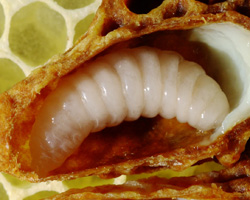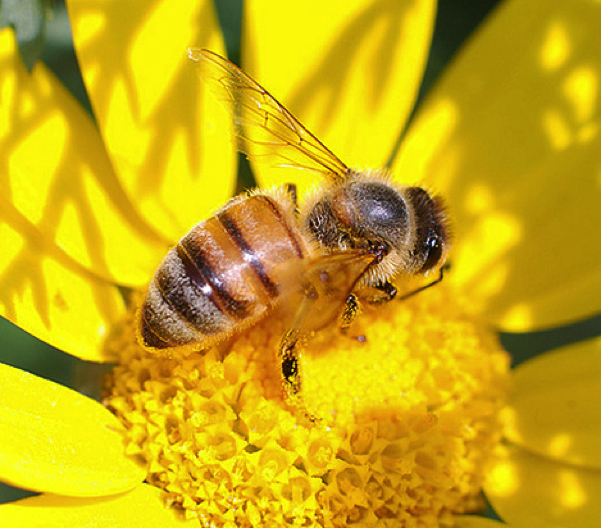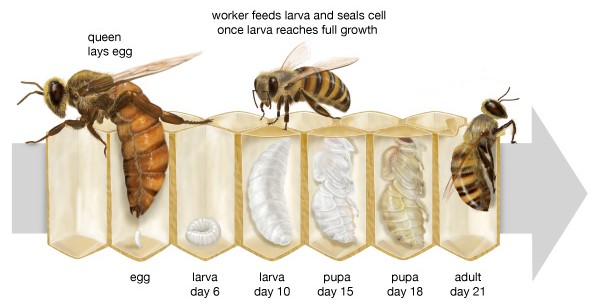
Life cycle of honey bee
- The life cycle of honey bee completes in four stages; egg, larva, pupa and adult.
- The queen bee emerges from the hive after 3 to 5 days of her complete development and mates with the males (drones).
- The flight of the queen bee and the drones outside the hive for mating is called nuptial flight or mating flight.
- After 2 to 3 days of mating, the queen starts laying eggs.
Egg:
- The queen bee lays a single egg in each hexagonal wax cell in the hive.
- The egg is small, white and elongated like a rice grain.
- Fertilized eggs (32 chromosomes) are laid in worker or queen cells while unfertilized eggs (16 chromosomes) in drone cells.
- When first laid, each egg stands vertically erect on the first day, bends over (leans on the wall) on the second day and on the third day lies on its side.
- After 3 days, the eggs hatch out into the larvae.

Larva:
- A white colored, blind and legless larva lies coiled on the bottom of the cell after hatching from the egg.
- Body can be divided into head, thorax and abdomen.
- For the first 3 days, all the larvae are fed with royal jelly (a protein-rich whitish milky fluid produced by worker bees when they are 7-11 days old).
- The larva destined to become a queen is fed with royal jelly throughout.
- The larvae of drones and workers are fed with bee bread (mixture of honey and pollen prepared by workers) after 3 days.
- The larval period is 5-5.5 days for queen, 6 days for worker and 6.5 days for drones.
- It eats, grows bigger and sheds its skin 5 times. There are 6 larval instars.
- When they are fully grown and no longer need to be fed (final instar larvae), worker bees cap their cells with a thin layer of wax.

Pupa:
- After complete development for 9 days, the larva spins a cocoon around itself on the 10th day and begins to pupate.
- This stage is a non-feeding and inactive stage.
- It lasts for 7.5 days in queen, 12 days in workers and 14.5 days in drones.
- During pupation, the adult body structures like head, thorax, abdomen and wings develop and the body grows darker.
- The energy required for the changes is provided by stored fats.

Adult:
- Once the pupa has transformed into an adult, it bites away the capping and emerges out of the cell.
- A newly emerged bee is light in color (grayish colored).
- The adult honey bee may be a queen, worker or drone depending on its genetic content and its food during its larval stage.
- It takes about 15-16 days for the queen, 20-21 days for the workers and 22-24 days for the drones to completely develop.
- The body structures and works performed by them are different.

Table: Time of development of different forms of honey bees (in days)
|
Forms |
Egg |
Larva |
Pupa |
Total |
|
Queen |
3 | 5.5 | 7.5 | 16 |
|
Worker |
3 |
6 | 12 |
21 |
| Drone | 3 | 6.5 | 14.5 |
24 |

Also see: Sericulture and life cycle of Silkworm
Why are honey bees useful to us?
- They are helpful in pollinating the flowers.
- They produce different types of useful substances like honey, wax, propolis, pollens etc.
Uses of honey:
- It is used as a source of natural sweets for preparing cakes, breads, biscuits etc.
- It is also used in the production of powerful tonics and syrups.
- Honey has a great medicinal value. It is a mild laxative, antiseptic and sedative.
- In helps in the formation of hemoglobin in anemic patients.
- It prevents cough, cold and fever.
Uses of bee wax:
- It is used in making cosmetics, face creams and polishes.
- It is also used in the production of paints, candles, carbon papers, lubricants etc.
- It is also said to have medicinal importance.